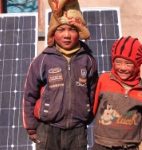Puntso’s yard is piled high with dung – specifically, wind-dried dung.
The 68-year old is a herder in the village of Niangqu, in the Nagqu area of Tibet. The household uses dung for fuel for cooking and winter heating.
Dung is an essential part of Tibetan life and is Tibet’s most common form of biofuel. The 420,000 residents of the Nagqu area burn an estimated two million tonnes of dung per year.
The dung would make good fertilizer to help the grass in the pastures grow. Its use as a primitive fuel source causes pollution and breaks the link between grass and grass-eating animals.
Research by the Academy of Agricultural Science’s Institute of Agricultural Environment and Sustainable Development and the Nagqu Agriculture and Livestock Bureau has shown that about one half of the pastures in the area are damaged – 300 million mu (20 million hectares) of land. The burning of dung is believed to be one cause of this.
Yet there is no way that dung can meet Tibet’s ever-growing demand for energy.
The Tibetan economy has grown rapidly in recent years. Infrastructure such as the Qinghai-Tibet railway and Nyingchi Airport are now up and running; the population has grown from 1.51 million in 1970 to 2.68 million in 2005 and energy shortages are worsening.
There are fossil fuels under the Tibetan soil – reserves of tens of millions of tonnes of coal have been identified in the Nagqu, Chamdo and Kailash areas. But there are no plans to mine these reserves, due to environmental and other considerations.
Currently Tibet imports hundreds of thousands of tonnes of coal and oil every year to ensure fuel is available for vehicles and other needs. Some of Punsto’s neighbours have bought cars now.
But unlike other areas of China, Tibet does not have coal-fired power stations, and there is a shortage of electricity throughout the region – from Nagqu in the north, Nyingchi in the south-east and even the capital Lhasa.
Tibet University’s Agricultural College, located in Nyingchi, often suffers blackouts in winter, with the teachers saying that the last two years have seen the school resort to diesel-powered generators.
There is no doubt that obtaining adequate energy sources is a major issue for Tibet.
Several years back a 10,000 yuan (US$6,000) subsidy from the government allowed Punsto to install a solar panel. It provides enough power for illumination and several hours of television every evening.
Tibet has rich solar resources. In some areas government projects are attempting to replace traditional fuels such as dung and firewood with solar cookers and methane. So what role can solar power play in the provision of electricity?
Three years ago the Chinese Academy of Sciences’ Institute of Electrical Engineering and Beijing Corona Co. built a 100 Kilowatt solar power station in Yangpachen. According to Corona engineer Lin Wei, this is the first solar power station to be hooked up to the electricity network – providing power for 150 households in Lhasa.
The project area is now the centre for renewable energy efforts in Tibet, and the government plans to build an even larger solar power station here.
Meanwhile in Nagqu, the government has funded solar panels in villages not connected to the power grid – Puntso’s family was one of the beneficiaries.
But solar power generating still has fatal flaws, including extremely high costs. The station in Yangbajing was not a commercial project; it was a trial supported by the Ministry of Science and Technology and the National Development and Reform Commission. All the funding came from government.
There are more solar power generators in Tibet than anywhere else in China, with hundreds at county or village level. But total generating capacity is no more than 9 megawatts. For the moment at least, the generation of electricity from solar power is unlikely to become widespread.
Solar power must also face the challenges from hydroelectric power.
A year ago, Punsto’s home was connected to an electricity network powered by hydropower. And the solar panel on his roof only supplies a few hundred watts of power – nowhere near enough to power appliances such as a refrigerator.
As herders’ homes have been connected to the electricity network, some solar panels are even falling into disuse – an awkward fact for a developing new source of energy.
Currently hydroelectricity is the rising star of Tibet’s energy sector. A 25-megawatt geothermal plant in Yangpachen once supplied 40% of Lhasa’s power. But with the construction of projects such as the pumped storage hydropower station at Yang Lake, that figure has dropped to only 10%.
And the construction of those hydroelectric plants is only getting started.
On the road between Lhasa and Nyingchi, I saw hydroelectric stations being constructed in Zhokha and Tiger Mouth, with the river having been dammed between precipitous cliffs.
These two plants are key parts of Tibet’s 11th Five Year Plan electricity capacity project. Work on the 700 million yuan (US$ 102 million), 40-megawatt Zhokha plant started in June 2006. On September 26of the same year the first generator started operation. The Tiger Mouth project features Tibet’s largest single hydroelectric generator, and on completion the 1.3 billion yuan (US$185 million) plant will produce 100 Mw of power.
Alongside these large and expensive projects, there are also several smaller hydroelectric plants in Tibet. Along the road through Nyingchi’s valley, I even came across a 3-Kilowatt plant providing power for a forestry station with only one occupant.
The construction of these facilities is always controversial. But at the least, these stations can provide the people of Tibet with power. After all, it is only in the last two years that Punsto’s family have had electricity, and there are still hundreds of thousands who do not.
But in the rush to build these plants, Tibet must not overlook environmental impact assessments and protection, and the door should be left open to new energy sources such as solar power.
Li Taige is a Beijing-based journalist. He obtained a master’s degree in engineering from Sichuan University in 1997 and was a Knight Science Journalism Fellow at the Massachusetts Institute of Technology (MIT) in 2003-04.



